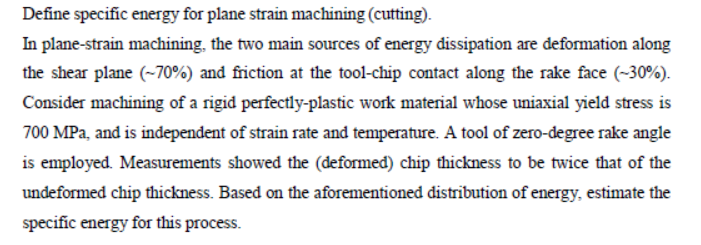Define specific energy for plane strain machining (cutting). In plane-strain machining, the two main sources of energy dissipation are deformation along the shear plane (~70%) and friction at the tool-chip contact along the rake face (~30%). Consider machining of a rigid perfectly-plastic work material whose uniaxial yield stress is 700 MPa, and is independent of strain rate and temperature. A tool of zero-degree rake angle is employed. Measurements showed the (deformed) chip thickness to be twice that of the undeformed chip thickness. Based on the aforementioned distribution of energy, estimate the specific energy for this process.
Define specific energy for plane strain machining (cutting). In plane-strain machining, the two main sources of energy dissipation are deformation along the shear plane (~70%) and friction at the tool-chip contact along the rake face (~30%). Consider machining of a rigid perfectly-plastic work material whose uniaxial yield stress is 700 MPa, and is independent of strain rate and temperature. A tool of zero-degree rake angle is employed. Measurements showed the (deformed) chip thickness to be twice that of the undeformed chip thickness. Based on the aforementioned distribution of energy, estimate the specific energy for this process.
Elements Of Electromagnetics
7th Edition
ISBN:9780190698614
Author:Sadiku, Matthew N. O.
Publisher:Sadiku, Matthew N. O.
ChapterMA: Math Assessment
Section: Chapter Questions
Problem 1.1MA
Related questions
Question

Transcribed Image Text:Define specific energy for plane strain machining (cutting).
In plane-strain machỉning, the two main sources of energy dissipation are deformation along
the shear plane (~70%) and friction at the tool-chip contact along the rake face (~30%).
Consider machining of a rigid perfectly-plastic work material whose uniaxial yield stress is
700 MPa, and is independent of strain rate and temperature. A tool of zero-degree rake angle
is employed. Measurements showed the (deformed) chip thickness to be twice that of the
undeformed chip thickness. Based on the aforementioned distribution of energy, estimate the
specific energy for this process.
Expert Solution
This question has been solved!
Explore an expertly crafted, step-by-step solution for a thorough understanding of key concepts.
This is a popular solution!
Trending now
This is a popular solution!
Step by step
Solved in 4 steps with 3 images

Knowledge Booster
Learn more about
Need a deep-dive on the concept behind this application? Look no further. Learn more about this topic, mechanical-engineering and related others by exploring similar questions and additional content below.Recommended textbooks for you

Elements Of Electromagnetics
Mechanical Engineering
ISBN:
9780190698614
Author:
Sadiku, Matthew N. O.
Publisher:
Oxford University Press

Mechanics of Materials (10th Edition)
Mechanical Engineering
ISBN:
9780134319650
Author:
Russell C. Hibbeler
Publisher:
PEARSON

Thermodynamics: An Engineering Approach
Mechanical Engineering
ISBN:
9781259822674
Author:
Yunus A. Cengel Dr., Michael A. Boles
Publisher:
McGraw-Hill Education

Elements Of Electromagnetics
Mechanical Engineering
ISBN:
9780190698614
Author:
Sadiku, Matthew N. O.
Publisher:
Oxford University Press

Mechanics of Materials (10th Edition)
Mechanical Engineering
ISBN:
9780134319650
Author:
Russell C. Hibbeler
Publisher:
PEARSON

Thermodynamics: An Engineering Approach
Mechanical Engineering
ISBN:
9781259822674
Author:
Yunus A. Cengel Dr., Michael A. Boles
Publisher:
McGraw-Hill Education

Control Systems Engineering
Mechanical Engineering
ISBN:
9781118170519
Author:
Norman S. Nise
Publisher:
WILEY

Mechanics of Materials (MindTap Course List)
Mechanical Engineering
ISBN:
9781337093347
Author:
Barry J. Goodno, James M. Gere
Publisher:
Cengage Learning

Engineering Mechanics: Statics
Mechanical Engineering
ISBN:
9781118807330
Author:
James L. Meriam, L. G. Kraige, J. N. Bolton
Publisher:
WILEY